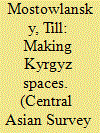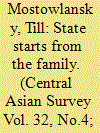|
|
|
Sort Order |
|
|
|
Items / Page
|
|
|
|
|
|
|
| Srl | Item |
| 1 |
ID:
115815


|
|
|
|
|
| Publication |
2012.
|
| Summary/Abstract |
In the past decade local scholars in Murghab, Tajikistan's easternmost district, have published several books in Kyrgyz on the history and culture of the Eastern Pamirs. In their work, the authors address the region's predominantly Kyrgyz population by emphasizing the 'kyrgyzness' of the Eastern Pamirs, which they refer to as Sarykol. The results of these local studies reverberate widely on the ground and have become integrated into everyday interaction. As a consequence, not only the region's history and culture, but also its territory, are perceived through an increasingly ethnicized lens. This paper seeks to explore local history as a way of appropriating space. Following Henri Lefebvre (1974), local history can be defined as an ethno-spatial practice that emphasizes ethnicity. Through an analysis of five works on local history and culture and their embedding in an ethnographic context, this article provides evidence for the significance of local studies in 'kyrgyzizing' space. It also demonstrates, moreover, that international non-governmental organizations, through their funding of such research, are entangled with globalized visions of culture, tradition and ethnicity.
|
|
|
|
|
|
|
|
|
|
|
|
|
|
|
|
| 2 |
ID:
126037


|
|
|
|
|
| Publication |
2013.
|
| Summary/Abstract |
Based on anthropological fieldwork between 2008 and 2011, this article focuses on how people in Tajikistan's eastern Pamirs conceptualize well-being through the establishment of peace and harmony. An exploration of the interactional use of the terms 'peace' and 'harmony' in Kyrgyz and Tajik (tynchtyk, yntymak, tinji, and vahdat) makes manifest that the meanings of these terms are connected to the fields of 'family', 'leadership', and 'state'. Basing their reasoning on the officially promoted analogy between family and state, people in the eastern Pamirs distinguish between social spaces that are related to well-being and those that are not. As a factor of distinction, and crucial to the establishment of peace and harmony, the moral quality of leadership plays an important role. Positive experiences of such leadership as balanced and morally pure are mainly identified and witnessed within families and neighbourhoods and only occasionally in state institutions. This discrepancy raises the question of where to locate boundaries between good and bad, moral and immoral, harmonious and conflictual. Thus, this article contributes not only to the study of local concepts of well-being in Central Asia but also to the study of local concepts of 'ill-being' which challenge them.
|
|
|
|
|
|
|
|
|
|
|
|
|
|
|
|
|
|
|
|
|